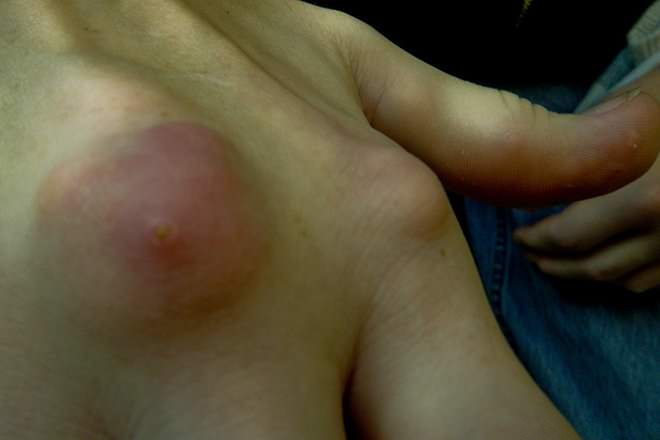Gout results from deposits of needle-like crystals of uric acid in connective tissue, joint spaces, or both. These deposits lead to inflammatory arthritis, causing swelling, redness, heat, pain, and stiffness in the joints. On the other hand, Osteoarthritis (OA) is not an autoimmune disease. It is a condition of wear and tear associated with aging or injury. The immune system is not affected.
Comparison chart
| | Gout | Osteoarthritis |
|---|---|---|
| Joint Symptoms | Arthritic joint pain, swelling, redness, warmth, and extreme tenderness. In some cases, the development of tophi | Joints painful but without swelling; affects joints asymmetrically; affects bigger joints such as hips & knees. Localized with variable, progressive course |
| Treatment | Resting the joint and applying ice, NSAIDS, corticosteroids, colchicine (a painkiller), medications that target uric acid production or excretion, healthy diet low in purines (from alcohol, meat, fish). | NSAIDs (short term use) Acetaminophen, Analgesics, exercise |
| Diagnosis | Imaging tests, drawing fluid from the swollen joint for analysis, blood tests | x-ray, pain assessment- perarticular and articular source of pain, presence of deformity, evidence of muscle wasting, local inflammation. asymmetrical joints |
| Presence of symptoms affecting the whole body (systemic) | Chills and a mild fever along with a general feeling of malaise may also accompany the severe pain and inflammation | Systemic symptoms are not present. Localized joint pain (Knee and hips) but NO swelling Pain severity is important (mechanical, inflammatory, noctornal, sudden) |
| Cause | Hyperuricemia — overabundance of crystalline monosodium urate (uric acid) deposits in the blood and joint fluid. | wear and tear associated w/ aging or injury, also caused by injuries to the joints, obesity, heredity, overuse of the joints from sports |
| Associated symptoms | Tophi may form.These are large masses of uric acid crystals, which gets collected in the joints and damage it.They also gets collected in the bone and cartilage, such as in the ears. | (no systemic symps) fatigue, muscle weakness, fever, organ involvement; Bony enlargement, deformity, instability, restricted movement, joint locked, sleep dist,depression, comorbid conditions (bursitis, fibromyalgia, gout) |
| Disease Process | metabolic desease | Normal wear and tear (chronic degenerative) |
| Gender | More common in men than women; in women after menopause | Common in both men and women. Before 50 more men than women, after 50 more women than men |
| Pattern of joints that are affected | Joint of the big toe most commonly affected. other joints affected are of ankle, heel, knee, wrist, fingers, elbow etc. | Asymmetrical & may spread to the other side. Symptoms begin gradually and are often limited to one set of joints, usually the finger joints closest to the fingernails or the thumbs, large weight-bearing joints, |
| Age of onset | usually over 35 yrs of age in men and after menopause in females | Over 60 |
| Speed of onset | sudden onset | Slow, over years |
Signs and symptoms
- OA stiffness tends to get worse with use throughout the day whereas stiffness due to gout is present only at the time of the attack.
- OA is associated with asymmetrical (not "matching") swelling in individual joints that are not part of a pair — e.g., one knee and an elbow, instead of both knees whereas Gout either involves a single joint or involves the joints in an asymmetric pattern.Generally, OA symptoms include joint stiffness, pain, and enlarged joints and it does not have any systemic symptoms.
- On the other hand the patient having Gout suddenly experiences a hot, red, swollen joint, caused by the formation of uric acid crystals between the joints. The attack often occurs at night and in a single joint, with the pain becoming more severe. Chills and a mild fever along with a general feeling of malaise may also accompany the severe pain and inflammation.
- In Gout although the pain and swelling disappear with treatment, it almost always returns in the same joint or in another one. Whereas OA is a continuous and progressive disease with no remissions.
Location of joints involved
With OA, inflammation generally occurs at the joint closest to your fingernail. On the other hand gout usually affects the joints in the big toe. Some other parts that could get affected by gout are ankle, heel, knee, wrist, fingers, elbow, etc.
Prevalence
Adult men, particularly those between the ages of 40 and 50, are more likely to develop gout than women, who rarely develop the disorder before menopause. People who have had an organ transplant are more susceptible to gout.
OA is much more common than Gout. In the United States alone, an estimated 20 million people have osteoarthritis.
References
- Essential Orthopaedics by J . Maheshwari
- Harrison’s Principles of Internal Medicine volume 1, 15th edition
- Current Medical Diagnosis and treatment, 2021; Lange publications
- wikipedia:Gout
- wikipedia: Osteoarthritis
- Once the Disease of Gluttonous Aristocrats, Gout Is Now Tormenting the Masses - The New York Times


 Gout
Gout  Osteoarthritis
Osteoarthritis  Type I
Type I  Back Pain
Back Pain  Cancer
Cancer
Comments: Gout vs Osteoarthritis